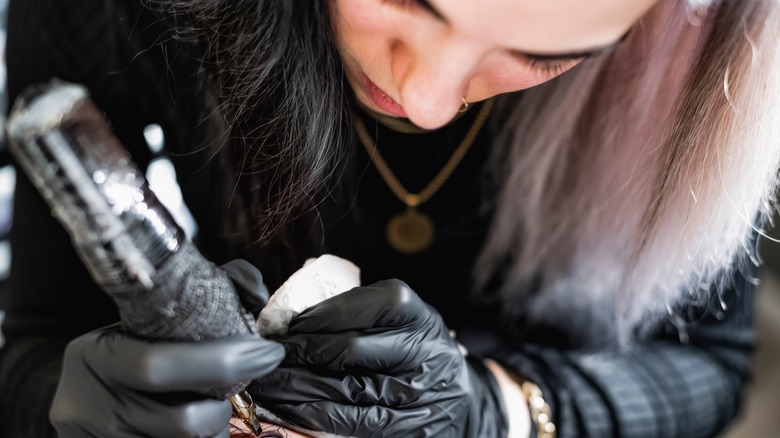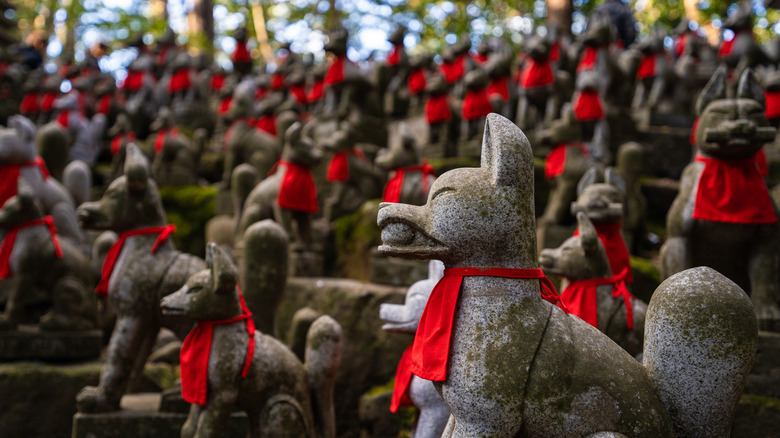The Real Meaning Of A Fox Tattoo
Once you've set your mind on getting a tattoo, the next hurdle is deciding what you want. Settling on something you want permanently inked on your body can be a tricky task, but it can be as easy as looking at the things most meaningful to you, like your favorite flower or animal. Animals are often one of the first ports of call for first tattoos, with many opting for creatures with powerful traits like lions or wolves (via Saved Tattoo).
But one animal that often gets overlooked is the fox. Foxes are one of nature's most fascinating creatures but are often misinterpreted as cunning and sly in popular culture, thanks to a history steeped in myths, folklore, and fairytales. As animal behavioral expert Jo Wimpenny told The Naked Scientists, this is especially true of Aesop's fables. In addition, Wimpenny notes that as "rapid learners," the tricks and skills foxes use to survive can often be misinterpreted as negative traits rather than positive ones.
While they may not be the most popular animal to have tattooed, there are a variety of meanings attached to the fox that you should know about.
Foxes are an important part of Japanese culture
In the traditional Japanese religion Shintoism, foxes are regarded as sacred creatures. Those possessing supernatural abilities are known as Kitsune, one of the oldest spirits in Japanese folklore (via Wonderful Japan). There are 13 different types of Kitsune, each corresponding to the elements. There are good ("zenko") and bad ("nogitsune") Kitsune, "representing the duality and balance of life on earth."
As these foxes grow older, they can grow nine extra tails signifying their power. Once a Kitsune has nine tails, their pelt turns white or gold, and they possess the ability to shapeshift into human form, per The National Sporting Library & Museum. Tattoos of Kitsune usually incorporate a nine-tailed fox or a mask worn by people during festivals and in tribute to the gods — specifically Inari (via Foxtume).
Aside from the Kitsune, foxes have a vital role in worshiping Inari, a kami spirit god "of rice, the protector of food, and bringer of prosperity," per World History. Inari can take on many forms, whether that be female or male. Shrines to Inari are surrounded by statues of foxes, who act as guardians and messengers to the god — specifically Myōbu, a while fox with a single tail (via TatRing).
Foxes are also a part of Celtic and Native American culture
Foxes also carry significance in other cultures, including Celtic and Native American folklore. Foxes were known as spirit guides in Celtic mythology and were once regarded as "wise creatures who knew the trees like no other," according to Astrology of the Ancients. The appearance of a fox symbolized a "need to think quickly and strategically" to the Celts, calling upon them to act with "cleverness and wisdom" as they adapted to unfamiliar situations. Like Shintoism, the Celtic fox could also shapeshift to slip "in and out of spots that might prove dangerous to others." The fox is also the Celtic animal sign for people born between May 13 and June 9.
In Native American folklore, foxes can mean different things to different tribes. As Native-languages.org notes, Blackfoot and Apache tribes associate the fox with fire and the sun. Some myths say the fox "stole fire to bring to the people." In Northeast, Midwest, and Plain tribes, the fox is seen as a minor spirit animal who occasionally lends a hand to "people or animals to solve a problem" or to punish those who are "careless or arrogant." Quechua and other Andean Indians view foxes as a bad omen, as they are often represented as thieves and "greedy scoundrels" in folktales.
The color of a fox's coat can say a lot in a tattoo
In general, foxes are known for being cunning, wise, and deceptive (via Tatt Mag). So if you relate to one or more of these personality traits, a fox tattoo can be a way to showcase a part of your personality. But as is the case with many animal tattoos, the action and color of a fox tattoo can signify even more profound meanings. For example, as Tatt Mag notes, a curled, sleeping fox can convey vulnerability. In contrast, a fox on the prowl or running can amplify its deceptive nature and represent how "you use deception to get what you want and to protect others."
Depending on a fox's habitat, the color of its coat can also hold significant meaning in tattooing. According to Tatt Mag, a silver coat can represent "refinement and taste" and even "an air of nobility" and provide good luck. A grey coat symbolizes maturity and shows a knack for solving problems, "using your intelligence and ability to be even-tempered." Whereas a white fox can be an expression of a "divine search for the meaning of life."



